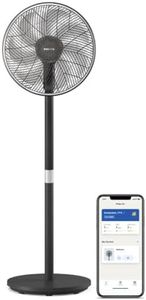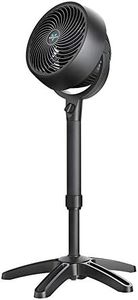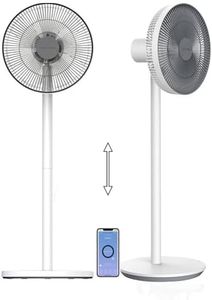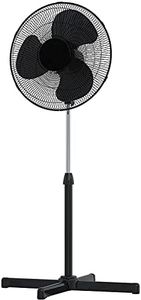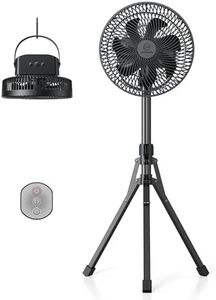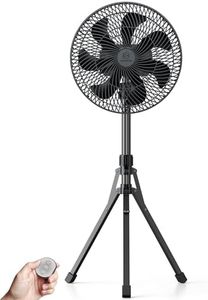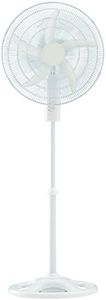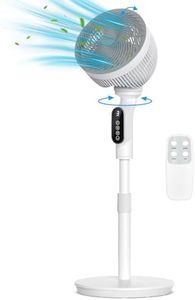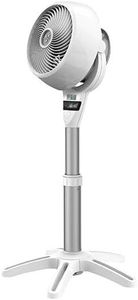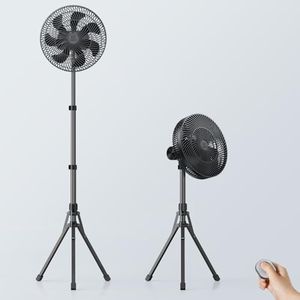We Use CookiesWe use cookies to enhance the security, performance,
functionality and for analytical and promotional activities. By continuing to browse this site you
are agreeing to our privacy policy
10 Best Pedestal Stand Fans
From leading brands and best sellers available on the web.Buying Guide for the Best Pedestal Stand Fans
Choosing the right pedestal stand fan can make a big difference in your comfort, especially during warmer months. It’s important to find a fan that not only cools effectively but also suits your space and needs. Before buying, consider where you'll use the fan, how much space you have, and whether special features like remote controls or oscillation are important to you. Understanding key features will help you make a decision that keeps you cool and happy.Fan Size (Blade Diameter)This refers to the diameter of the fan’s blades, typically measured in inches or centimeters. Fan size determines how much air the fan can move; larger blades can push more air, covering a bigger area. Smaller fans (10-12 inches) are good for compact spaces or personal use, while medium (14-16 inches) and large fans (18 inches and beyond) can cool bigger rooms or groups of people. Pick the size that matches the size of your room and how many people need to feel the breeze.
Air Delivery / Airflow (CFM or m³/min)Air delivery, often shown as CFM (cubic feet per minute) or cubic meters per minute, measures how much air the fan moves. The higher the number, the stronger and wider the airflow. Low airflow fans are suitable for gentle cooling or small rooms, medium airflow suits bedrooms or medium-sized spaces, and high airflow is ideal for large living areas or when you need quick cooling. Think about whether you want a gentle breeze for personal comfort or strong airflow for quick cooling.
Speed SettingsMost stand fans come with adjustable speed settings, typically ranging from two to five levels. More speed options give you better control over the intensity of cooling. Fewer speeds mean simpler operation, while more speeds let you fine-tune how much air the fan pushes. Choose a fan with enough speed options to fit your comfort preferences, especially if you'll use it in different seasons or for both day and night.
OscillationOscillation is the fan’s ability to move from side to side, dispersing air throughout a wider area. With fixed (non-oscillating) fans, airflow is directed in a single direction, while oscillating fans can cover more people or a larger part of a room. If you want the fan to cool more than one spot or several people at once, pick a model with oscillation. For focused airflow, a fixed head might be sufficient.
Height AdjustabilityThis feature lets you raise or lower the fan head to direct airflow where you want. Greater adjustability means the fan can be used while standing, sitting, or even sleeping. Fans with limited height adjustment are more fixed and less versatile. Think about where you'll place the fan and how you'd like to direct the air – more adjustable fans are great for spaces with different seating or sleeping arrangements.
Noise LevelNoise level refers to how loud the fan is when running, often measured in decibels. Some fans are quieter and better for bedrooms or offices, while others are louder due to stronger motors. If you are sensitive to noise or plan to use the fan while sleeping or working, look for one with a lower noise rating. For living rooms or outdoor spaces, a bit more noise might not be an issue.
Build Quality and MaterialStand fans are made from different materials like plastic or metal, which affects their stability and durability. Metal fans are often sturdier and last longer but can be heavier, while plastic fans are lighter and easier to move. If you plan to move the fan frequently or use it in one spot, consider the weight and sturdiness that matches your use.
Controls (Manual or Remote)Fans come with traditional manual dials/buttons or modern remote controls. Manual controls are simple and reliable, while remotes add convenience, especially if you want to change settings from a distance. If ease of use or mobility is important, look for a model with a remote; otherwise, manual controls might be all you need.
